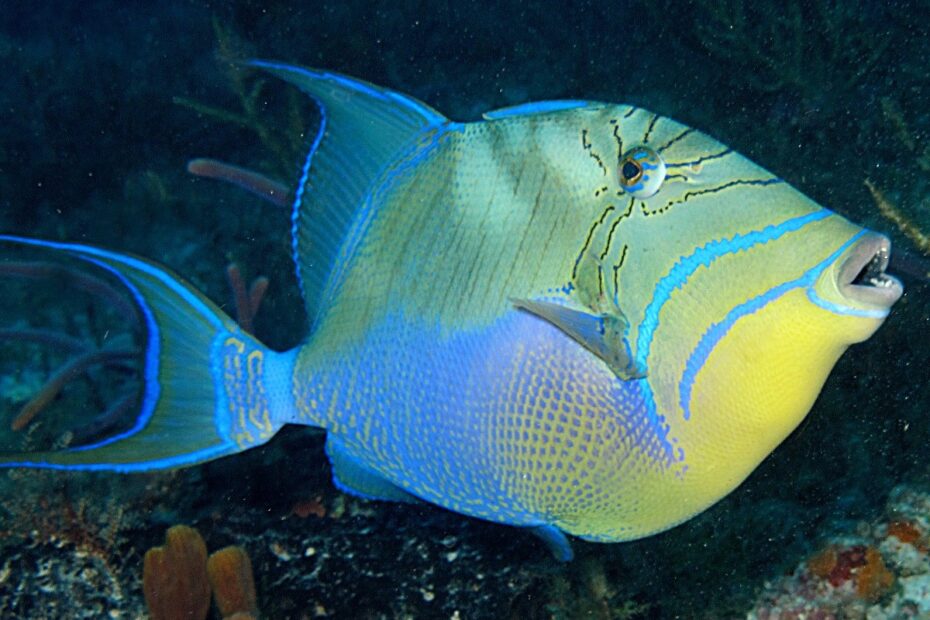Queen Triggerfish (Balistes vetula)
• Small fish safe: ❌ No (will prey on smaller fish)
• Small invert safe: ❌ No (actively hunts crustaceans and mollusks)
• Coral safe: ❌ No (may nip at corals and rearrange rockwork)
• Minimum tank size: 750 liters (200 gallons) for juveniles, 1,000+ liters (265+ gallons) for adults
• Adult size: Up to 60 cm (24 inches)
• Diet: Carnivorous, feeding on crustaceans, mollusks, sea urchins, and small fish
• Be aware of: Highly aggressive and territorial; capable of biting reef keepers; needs ample space and secure rockwork
Appearance and Coloration
The Queen Triggerfish is one of the most strikingly colored triggerfish, featuring a bright turquoise body with fluorescent blue and yellow markings around the face and fins. Its elongated dorsal and anal fins give it a streamlined, almost regal appearance, while its strong jaws allow it to crush hard-shelled prey.
A distinguishing feature of Balistes vetula is its intense coloration, which can change based on mood or environment. When stressed or excited, their blue and yellow hues may become more pronounced.
Natural Habitat and Behaviour
Native to the Atlantic Ocean, Balistes vetula is found in tropical coral reefs, rocky areas, and seagrass beds at depths ranging from 2 to 100 meters (6 to 330 feet). It is especially common in the Caribbean and Gulf of Mexico.
In the wild, Queen Triggerfish are aggressive predators, known for their ability to flip over sea urchins to access their soft underside. They are also extremely territorial and will chase away intruders, including divers.
Tank Requirements and Water Parameters
• Minimum Tank Size: 200 gallons (750 liters) for juveniles, 265+ gallons (1,000+ liters) for adults
• Water Parameters:
• Temperature: 24°C – 28°C (75°F – 82°F)
• pH: 8.1 – 8.4
• Specific Gravity: 1.020 – 1.025
• Aquascaping:
• Provide large caves and rock formations to create hiding spots.
• Avoid loose decorations, as Queen Triggers will move rocks and objects in the tank.
• Ensure ample open swimming space for this active species.
• Lighting: Moderate to bright reef lighting.
• Water Movement: Moderate to strong, simulating natural reef conditions.
Diet and Feeding
Queen Triggerfish are voracious predators that require a high-protein diet consisting of hard-shelled invertebrates to keep their strong teeth naturally filed down.
• Natural Diet: Sea urchins, crabs, mollusks, and small fish.
• Captive Diet:
• Chopped seafood (shrimp, squid, clams, mussels).
• Frozen marine foods designed for large carnivorous fish.
• Hard-shelled foods (snails, crabs, whole shrimp) to prevent overgrown teeth.
• High-quality marine pellets and flakes (as supplements).
Feeding Frequency: 2-3 times per day to support their high metabolism and reduce aggression.
Compatibility and Social Structure
• Temperament:
• Extremely aggressive and territorial, especially as they mature.
• Will actively chase, nip, and attack tank mates in confined spaces.
• Tank Mates:
• Only suitable for large, aggressive fish, such as:
• Groupers
• Large angelfish
• Puffers
• Other large triggerfish (only in massive tanks)
• Avoid housing with smaller or passive species, as they will be harassed or eaten.
• Not suitable for peaceful community or reef tanks.
• Reef Compatibility: ❌ Not reef-safe—will eat invertebrates, damage corals, and disturb rockwork.
Important Considerations
• Highly Aggressive: One of the most aggressive triggerfish, requiring a skilled reef keeper to manage their behavior.
• Biting Behavior: Known to bite hands, equipment, and tank decorations. Extreme caution is required when performing maintenance.
• Rearranges Tank Decorations: Will move rocks and shells, potentially toppling unsecured structures.
• Teeth Growth: Requires hard-shelled food (like mussels or snails) to wear down their ever-growing teeth.
• Tank Size Matters: Needs a massive aquarium (at least 1,000 liters/265 gallons) when fully grown due to their size and aggressive nature.
